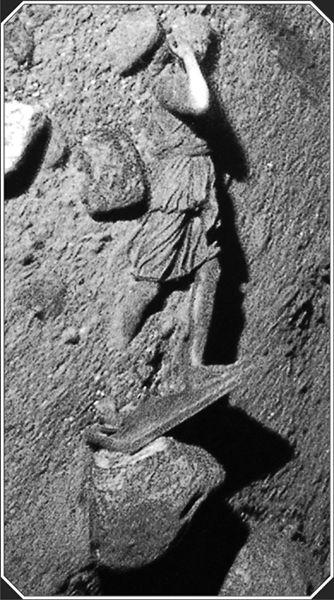Read Gilded Lives, Fatal Voyage: The Titanic's First-Class Passengers and Their World Online
Authors: Hugh Brewster
Tags: #Ocean Travel, #Shipwreck Victims, #Cruises, #20th Century, #Upper Class - United States, #United States, #Shipwrecks - North Atlantic Ocean, #Rich & Famous, #Biography & Autobiography, #Travel, #Titanic (Steamship), #History
Gilded Lives, Fatal Voyage: The Titanic's First-Class Passengers and Their World


(photo credit 1.53)
(photo credit 1.11)

This Page
: The
Titanic
’s sinking was a huge news story.
This Page
: A photograph of the near-identical sister ship,
Olympic
, leaving port on sailing day evokes the
Titanic
’s departure on April 10, 1912.
Copyright © 2012 by Hugh Brewster
All rights reserved.
Published in the United States by Crown Publishers, an imprint of the Crown Publishing Group, a division of Random House, Inc., New York.
www.crownpublishing.com
Simultaneously published in Canada by Collins Canada, an imprint of HarperCollins Publishers Ltd.
CROWN and the Crown colophon are registered trademarks of Random House, Inc.
Library of Congress Cataloging-in-Publication Data
Brewster, Hugh.
Gilded lives, fatal voyage: the Titanic’s first-class passengers and their world /
Hugh Brewster.
1. Titanic (Steamship). 2. Titanic (Steamship)—Biography. 3. Upper class—United States—Biography. 4. Ocean travel—Anecdotes.
5. Shipwreck victims—Biography. 6. Shipwrecks—North Atlantic Ocean.
I. Title. II. Title: The Titanic’s first-class passengers and their world.
G530.T6B73 2011
910.9163#4—dc23 2011037159
eISBN: 978-0-307-98471-5
Front jacket illustration: Corbis; photographs, from left: Randy Bryan Bigham Collection, American Academy of Arts and Letters Collection, Randy Bryan Bigham Collection, Library of Congress Photographic Archive
Photograph and illustration credits appear on
this page
.
v3.1
To George Behe
,
Randy Bryan Bigham
,
and
Don Lynch
,
with thanks
“It was a brilliant crowd … a rare gathering of
beautiful women and splendid men.”
—First-cabin passenger
LILY MAY FUTRELLE
CONTENTS
Cover
Title Page
Copyright
Dedication
Epigraph
Prologue
|
A RARE GATHERING
1
|
AT THE CHERBOURG QUAY
2
|
A
NOMADIC
HIATUS
3
|
THE PALM ROOM
4
| “
QUEER LOT OF PEOPLE
”
5
|
QUEENSTOWN
6
|
FELLOW TRAVELERS
7
|
PRIVATE LIVES
8
|
SHIPBOARD COTERIES
9
|
DESIGNING WOMAN
10
|
A CALM SUNDAY
11
|
THE LAST EVENING
12
|
COLLISION AND AFTER
13
|
TO THE LIFEBOATS
14
|
THE FINAL MINUTES
15
|
VOICES IN THE NIGHT
16
|
THE SHIP OF SORROW
17
|
TWO CONTINENTS STIRRED
Postscript
|
TITANIC
AFTERLIVES
NOTES
APPENDIX A
APPENDIX B
BIBLIOGRAPHY
ACKNOWLEDGMENTS
PHOTOGRAPH AND ILLUSTRATION CREDITS
About the Author
(photo credit 1.90)

C
aught in the lights of the submarine was a small statue of a Greek goddess. She lay on the soft abyssal mud surrounded by lumps of coal, porcelain sinks, silver serving trays, filigreed windows, a china doll’s head, champagne bottles, and much more. No light had ever before been shone on this extraordinary underwater cabinet of curiosities.
But with more of the
Titanic
’s wreck site left to explore, the submarine
Alvin
soon left the debris field and moved on. By early August of 1986, explorer Robert Ballard and his team were back at the Woods Hole Oceanographic Institution in Massachusetts with miles of film footage and hundreds of still photographs. My job for the next year was to edit and compile Dr. Ballard’s images and data into a book about his discovery and exploration of the lost liner.
Fortunately, to share the task there was Ken Marschall, the world’s foremost painter of the
Titanic
and a font of knowledge about the ship. When I asked him about the Greek goddess, he produced a photograph of the first-class lounge, one of the most elegant of the liner’s public rooms. On its marble fireplace stood a statuette that was a match for the one on the ocean floor. It proved to be a reproduction of the
Artemis of Versailles
, a renowned Roman sculpture, from a Greek original, that Louis XIV had once installed in his palace’s Grande Galerie. The statuette was an appropriate piece of décor for the
Titanic
’s lounge which was described in a 1912 shipbuilding magazine as “
a noble apartment … the details being taken from the Palace of Versailles.” The
Artemis
of the
Titanic
, however, had been made of an inexpensive zinc alloy known as spelter, and then gilded. On the ocean floor, its gilding had been eaten away, leaving only the dull, gray metal underneath. For a ship that has come to represent the sunset of the Gilded Age, the spelter statuette seems an apt symbol.
The
Titanic
’s story, however, has lost none of its sheen. On the eve of its centenary it remains what Walter Lord, the author of
A Night to Remember
, once labeled “
the unsinkable subject.” It has inspired hundreds of books, movies, and websites, and one hesitates to launch another craft into such crowded sea-lanes. Yet in most accounts of the disaster, the
Titanic
is the protagonist and her passengers merely supporting players, identified with tags like “millionaire John Jacob Astor,” “crusading journalist W. T. Stead,” and “fashion designer Lady Duff Gordon.” Yet who were these people? And what had brought their lives to this fateful crossing?
To Lily May Futrelle, her fellow travelers were “
a rare gathering of beautiful women and splendid men.” A rare gathering it was—liner historians report that no other passenger list of the period ever featured quite as many celebrated names. For Lady Duff Gordon, the
Titanic
was “
a small world bent on pleasure.” And it was indeed a smaller world than ours—the populations of the United States and Canada were a third of what they are today (and Great Britain’s a third less), and wealth and influence were concentrated in much tighter circles. Those who made ocean crossings regularly usually found acquaintances on the first-class passenger list.
But “bent on pleasure”? There was certainly a contingent of the transatlantic leisured rich on board, a recently evolved class of Americans who kept homes in Paris or regularly made the crossing for the winter “season” in London or on the Continent. But many of the liner’s first-class cabins were occupied by hardworking high achievers. The artist Frank Millet, for example, was on his way to Washington to help decide on the design for the Lincoln Memorial. His friend, White House aide Archie Butt, was heading home to prepare for a grueling presidential election campaign. Railroad president Charles Hays was returning to Canada for the opening of his company’s new Château Laurier Hotel in Ottawa. Lady Duff Gordon herself was a leading British couturiere who had urgent business to tend to at her New York salon. Within their lives and those of others on board can be found a remarkable convergence of the events, issues, and personalities of the age, forming what Walter Lord called “
an exquisite microcosm of the Edwardian world.”


